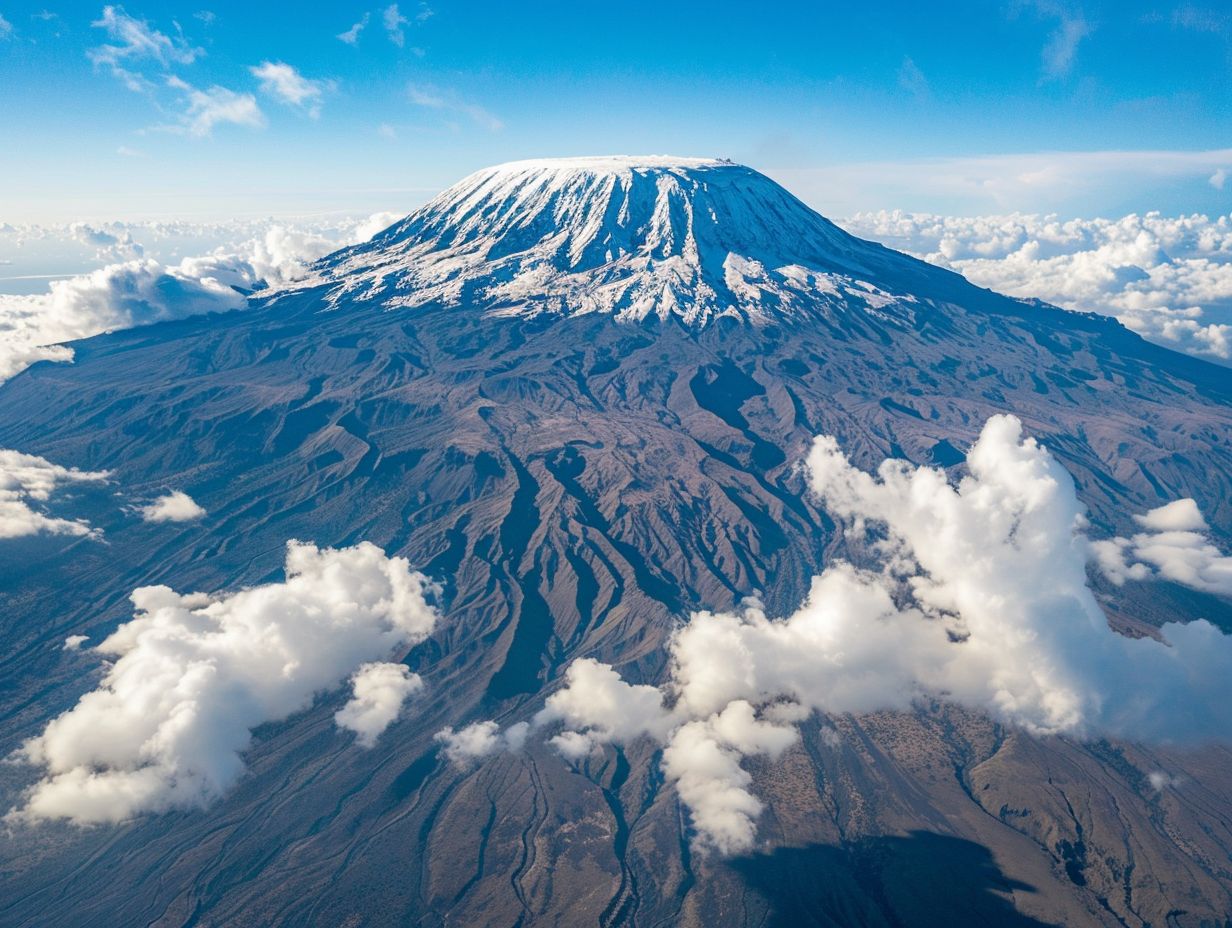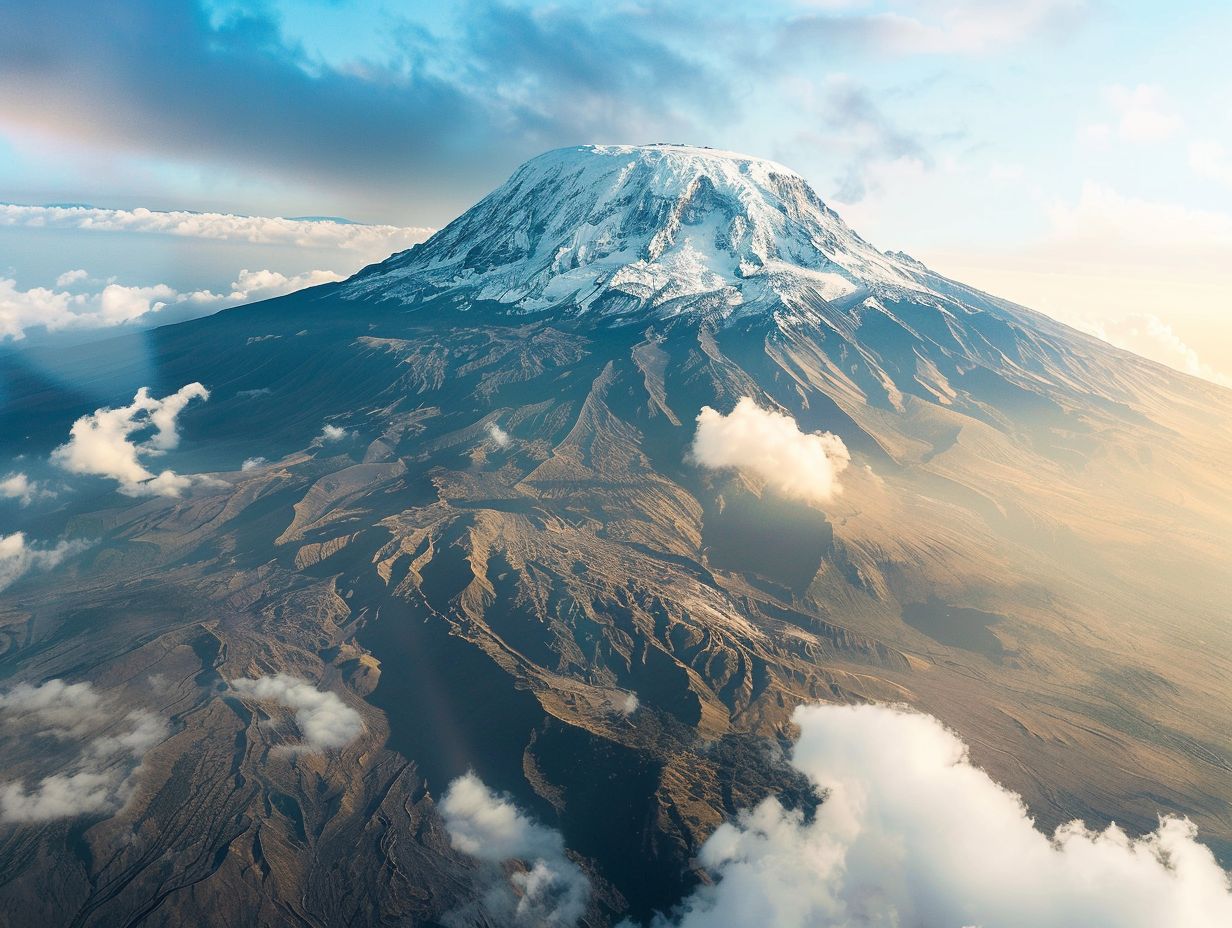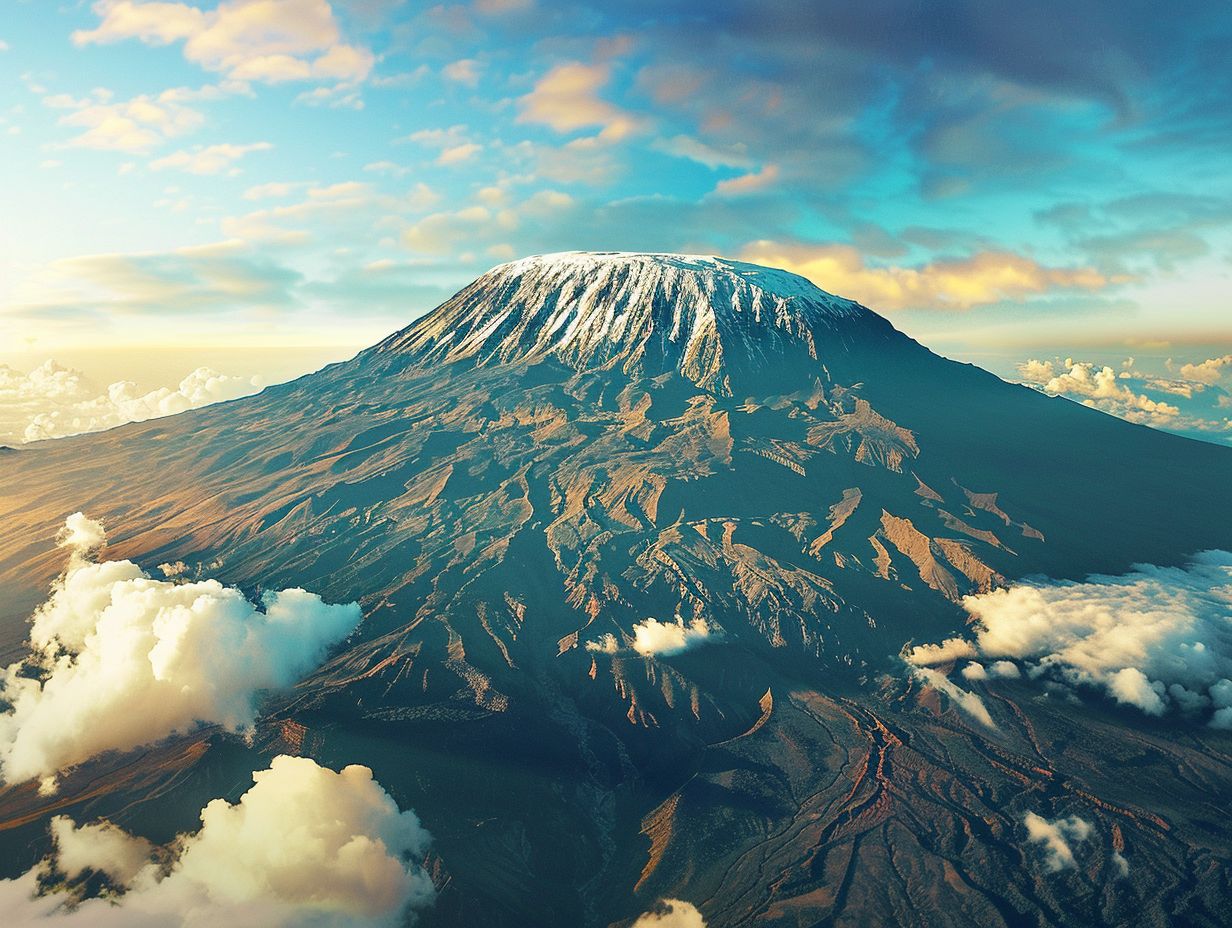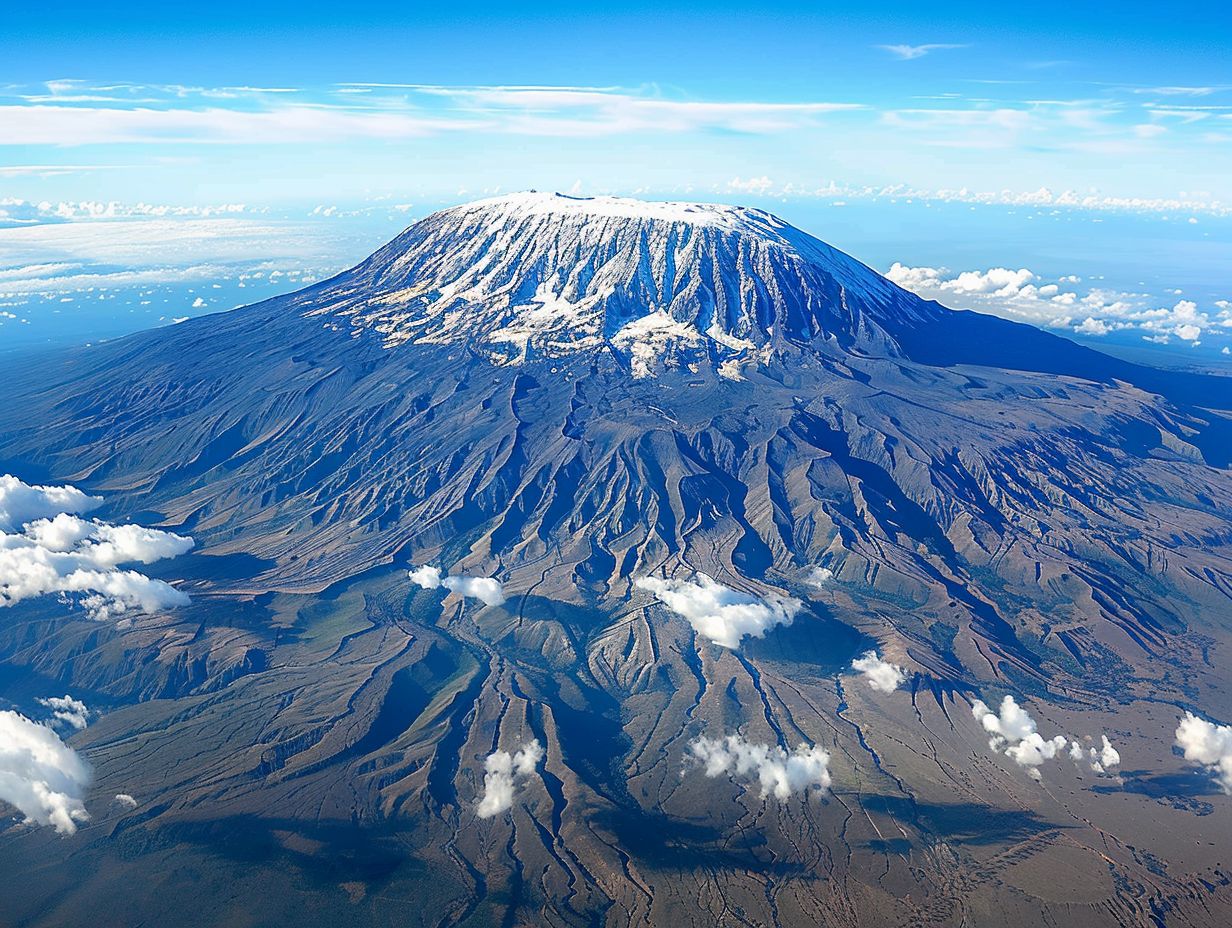
Mount Kilimanjaro, Africa’s tallest peak, holds a fascinating geological history waiting to be explored. From its composition to the role of plate tectonics in its formation, this article delves into the intricate details of Mount Kilimanjaro’s geology.
Discover the different types of rocks found on the mountain and the theories surrounding its formation. Learn about the current state of Mount Kilimanjaro’s geology, including any ongoing volcanic activity and the impact of erosion.
Join us on a journey to uncover the geological wonders of Mount Kilimanjaro.
Key Takeaways:

- Mount Kilimanjaro’s geology is complex, with a variety of rock types and evidence of plate tectonics.
- The formation of Mount Kilimanjaro is still debated, but theories suggest a combination of volcanic activity and tectonic movements contributed.
- Today, Mount Kilimanjaro is not actively volcanic, but erosion continues to shape its geology and landscape.
What is the Geology of Mount Kilimanjaro?
Mount Kilimanjaro, located in Tanzania, is a stratovolcano formed over millions of years due to the complex interplay of tectonic plates, geological forces, and volcanic activity in the region.
The tectonic plates of the African continent played a vital role in the creation of Mt. Kilimanjaro as they shifted and collided, leading to the uplift of this majestic peak.
The perennial volcanic activity in the area further shaped the mountain, with eruptions depositing layers of volcanic ash and lava that gradually built up its distinctive conical form.
With its three main peaks – Kibo, Mawenzi, and Shira, Kilimanjaro stands as a testament to the enduring power of geological processes. The erosion caused by glaciers and streams combined with the unique geological makeup of the mountain, characterized by ancient rocks and sediments, have sculpted the rugged terrain we see today.
What is the Composition of Mount Kilimanjaro?
Mount Kilimanjaro’s composition consists of layers of volcanic rock, including obsidian and andesite, formed through past volcanic eruptions.
Obsidian, a natural volcanic glass, is found in the form of black or dark-colored rocks on Mount Kilimanjaro. This type of rock is characterized by its smooth and shiny texture, making it prized for ancient civilizations for creating tools and weapons.
Andesite, on the other hand, is a fine-grained rock rich in silica and typically has a gray to black color. These diverse rock formations provide valuable insights into the geological processes that shaped Mount Kilimanjaro over millions of years.
How do Plate Tectonics Play a Role in the Formation of Mount Kilimanjaro?
Plate tectonics have been instrumental in shaping Mount Kilimanjaro, with the convergence and movement of tectonic plates creating the conditions for its formation along the Great Rift Valley.
The geological evolution of Mount Kilimanjaro has been significantly influenced by the dynamic processes of plate tectonics. The movement of the African Plate over the past millions of years has led to the uplift and formation of this majestic peak.
The interactions between the African Plate and the Somali Plate have contributed to the creation of the East African Rift, a geological marvel that includes Mount Kilimanjaro. These tectonic activities have not only shaped the mountain’s structure but also continue to impact its geological features through volcanic activity and faulting.
What are the Different Types of Rocks Found on Mount Kilimanjaro?
The rocks on Mount Kilimanjaro showcase the remnants of past volcanic eruptions, with layers of volcanic ash, magma, and other igneous materials contributing to the mountain’s unique geology.
These igneous rocks, formed from molten lava cooling and solidifying, can be spotted in various parts of the mountain, reflecting its fiery past.
The different types of volcanic rocks, including basalt, rhyolite, and obsidian, provide clues about the intense heat and pressure that once existed beneath the surface. Their presence suggests a tumultuous history of volcanic activity that has shaped Kilimanjaro’s landscape over millions of years.
What is the Geological History of Mount Kilimanjaro?

Mount Kilimanjaro has a rich geological history, having transitioned from an active volcanic peak to its current status as a dormant volcano, shaped by erosion and other geological forces over millennia.
The geologic evolution of Mount Kilimanjaro is a fascinating tale of transformation. Originally, this majestic mountain was a fiery cauldron of magma and volcanic activity, spewing lava and ash into the surrounding landscape. Over time, the once fiercely active volcano gradually calmed, entering a dormant state that it maintains today.
The forces of erosion, including glaciers and streams, have played a significant role in shaping Kilimanjaro’s rugged terrain, sculpting its peaks and valleys into the stunning landscape we see today. Erosion has chiseled away at the volcanic rock, exposing the stratigraphy of the mountain and revealing its geological history.
How Was Mount Kilimanjaro Formed?
Mount Kilimanjaro’s formation is a testament to the powerful geological forces at play, shaping its distinctive rock layers and structure through tectonic plate movements and volcanic activities.
The formation of Mount Kilimanjaro began millions of years ago as a result of intense geological processes. The mountain’s roots lie in the movements of tectonic plates, where the African Plate and the Somali Plate collided, leading to the uplift of the region.
Over time, the accumulation of multiple layers of volcanic rocks and sediments further shaped the mountain’s topography. The geological forces responsible for Mount Kilimanjaro’s creation continue to exert their influence, sculpting its peaks and valleys into the iconic landmark we see today.
What are the Different Theories of Mount Kilimanjaro’s Formation?
Several theories exist regarding the formation of Mount Kilimanjaro, with discussions revolving around fault block mountain formation, volcanic mountain processes, and other geological phenomena.
One prevalent theory suggests that Mount Kilimanjaro is a result of fault block mountain formation, where tectonic forces cause blocks of the Earth’s crust to move vertically. This movement creates large fractures and uplifts, shaping the landscape we see today.
Another proposed explanation revolves around volcanic mountain processes, indicating that the mountain may have formed through volcanic activity, with successive eruptions building up its mass over time. Some geologists propose that the mountain’s origin could be linked to other geological phenomena such as erosion, glaciation, and sedimentation, which have contributed to its current form.
What Processes Contributed to the Formation of Mount Kilimanjaro?
The formation of Mount Kilimanjaro was influenced by a combination of volcanic activity, lava formations, geological processes, and the movements of tectonic plates over geological timescales.
Volcanic activities in the region led to the accumulation of layers of molten rock, creating the foundation upon which Mount Kilimanjaro would eventually rise. Over millions of years, ongoing eruptions deposited layers of lava, contributing to the mountain’s mass and height.
The underlying geology of the area, primarily consisting of volcanic rocks and ash, played a pivotal role in shaping the mountain’s distinct features. The slow but powerful movements of tectonic plates, particularly the East African Rift, exerted immense pressure and forces that uplifted and molded Kilimanjaro into the iconic peak we see today.
What is the Current State of Mount Kilimanjaro’s Geology?
The current geological state of Mount Kilimanjaro is characterized by its iconic glaciers, remnants of past volcanic activities, erosion patterns, and lava formations that showcase its dynamic geological history.
Mount Kilimanjaro, Africa’s highest peak, stands majestically with its snow-capped summit creating a breathtaking spectacle in the heart of Tanzania. The glaciers, such as Furtwängler Glacier, on the mountain’s higher slopes are a prominent feature, albeit diminishing due to climate change.
Erosion has played a significant role in shaping Kilimanjaro’s geology, evident in the deep valleys and ridges that adorn its slopes. The lava formations and ash remnants offer valuable clues about the mountain’s volcanic history, revealing a time when molten magma sculpted the landscape.
Are There Any Ongoing Volcanic Activity on Mount Kilimanjaro?

Currently, Mount Kilimanjaro does not exhibit any active volcanic activity, with historical records indicating past eruptions that have contributed to the mountain’s existing magma and volcanic rock formations.
The last major eruption of Mount Kilimanjaro occurred more than 360,000 years ago, shaping the landscape through lava flows and ash deposits. Over time, the solidified magma has formed distinctive volcanic rocks, such as tuff and obsidian, found on the mountain.
Despite the lack of recent volcanic eruptions, scientists continue to monitor Kilimanjaro for any signs of volcanic unrest, given its position within the East African Rift. The presence of magma beneath the mountain indicates the potential for future volcanic activity, albeit not imminent.
How Has Erosion Affected Mount Kilimanjaro’s Geology?
Erosion has played a significant role in sculpting Mount Kilimanjaro’s landscape, particularly evident in the melting of glaciers due to climate change and its impact on the mountain’s geological makeup.
Due to the continuous effects of erosion, Mount Kilimanjaro’s geographical features have undergone remarkable transformations over the centuries. The process of erosion, accelerated by environmental factors like deforestation and altered precipitation patterns, has led to a visible alteration in the mountain’s topography.
As the glaciers retreat at an alarming rate, both the physical structure and the ecological balance of the mountain are being profoundly affected. The altered weather conditions caused by climate change further exacerbate the erosion process, posing a serious threat to the mountain’s delicate ecosystem.
Conclusion
In conclusion, Mount Kilimanjaro stands as a geological marvel, attracting climbers from around the world to conquer its summit, known as one of the acclaimed Seven Summits and offering a glimpse into the intricate geological processes that have shaped this majestic mountain.
One of the key aspects of Mount Kilimanjaro’s geology is its volcanic origin, with three distinct volcanic cones – Kibo, Mawenzi, and Shira – composing the mountain. The stratovolcano nature of Kilimanjaro, formed over millions of years, adds to its allure as a challenging yet rewarding mountaineering destination.
Its unique position near the equator and the geological formations created by successive volcanic activities have also made it a significant focal point for researchers studying glacial retreat and climate change impacts on high-altitude environments.
The diverse terrain that includes glaciers, alpine deserts, and lush rainforests makes the climb a visually stunning and geologically educational adventure for those seeking to explore this iconic peak.”
Frequently Asked Questions
1. How was Mount Kilimanjaro formed geology?
Mount Kilimanjaro was formed through a series of volcanic eruptions that occurred over millions of years. These eruptions were a result of the movement of tectonic plates beneath the Earth’s surface.
2. Were there any glaciers involved in the formation of Mount Kilimanjaro?

Yes, glaciers played a significant role in shaping the landscape of Mount Kilimanjaro. The volcanic activity combined with the glaciers’ movement created the distinct features of the mountain that we see today.
3. How long did it take for Mount Kilimanjaro to form?
The formation of Mount Kilimanjaro started approximately 3 million years ago and continues to this day. The mountain has gone through various stages of growth and erosion, which have shaped its current appearance.
4. What type of rock makes up Mount Kilimanjaro?
Mount Kilimanjaro is primarily made up of three types of rocks: volcanic rocks, sedimentary rocks, and metamorphic rocks. The volcanic rocks are the result of the mountain’s formation, while the other two types were formed from the erosion of older rocks.
5. How does the geology of Mount Kilimanjaro affect its surrounding environment?
The geology of Mount Kilimanjaro has a significant impact on its surrounding environment. The volcanic rocks and soils provide nutrients for the diverse flora and fauna that call the mountain home, while the glaciers and snowmelt contribute to the water sources for nearby communities.
6. Will the geology of Mount Kilimanjaro continue to change in the future?
Yes, the geology of Mount Kilimanjaro will continue to evolve as the mountain is still an active volcano. Eruptions and earthquakes may occur, causing changes in the landscape. Additionally, climate change is causing the glaciers to melt at an accelerated rate, which will also impact the mountain’s geology.